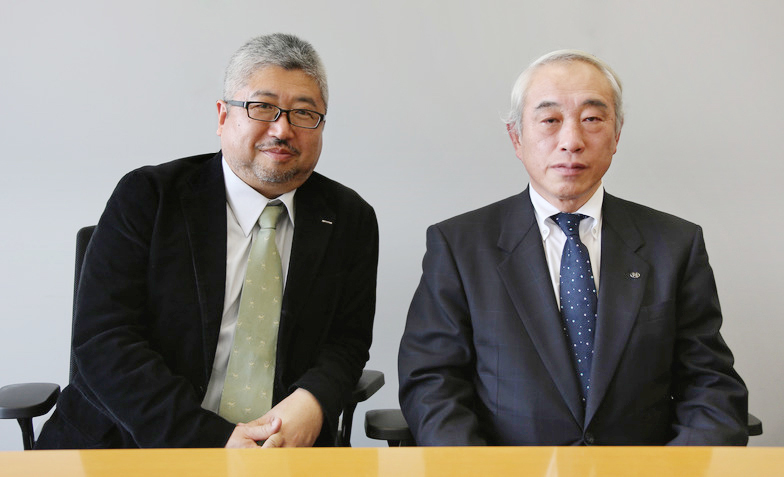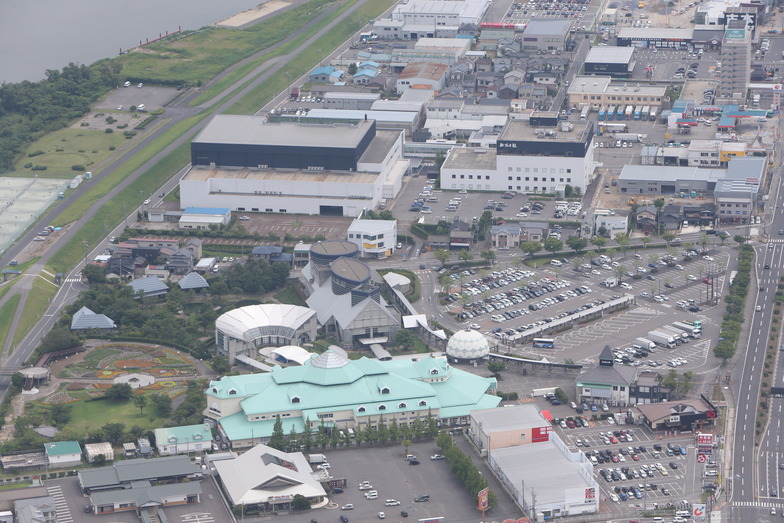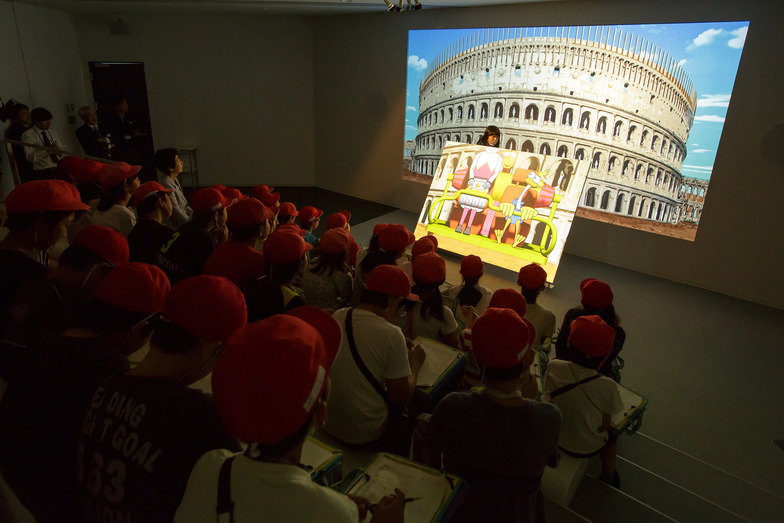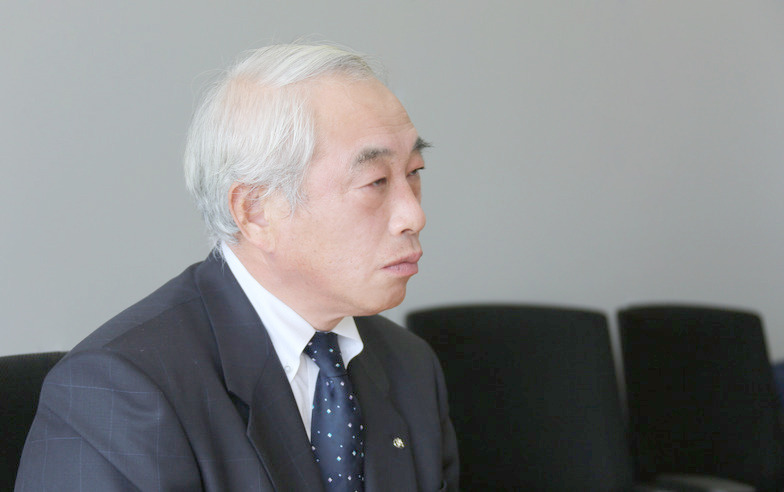In September 2014, the "Fun Newspaper Museum" opened next to the Niigata Nippo newspaper's Kurosaki headquarters. The project team from the Niigata Nippo and Dentsu Inc. positioned this facility not merely as a "box," but as a new communication platform connecting with the local community and future readers. They advanced the project as an initiative where all Niigata Nippo employees committed to "the future of newspapers." One year after opening, Hideaki Adachi, Managing Director of the Niigata Nippo, and Yoichi Matsumoto of Dentsu Inc. discuss the process, outcomes, and challenges.
Reporting & Editing: Aki Kanahara, Dentsu Inc. Event & Space Design Bureau

(From left) Mr. Matsumoto, Mr. Adachi
Considering the essence and future of newspapers with all Niigata Nippo employees
Matsumoto: While operating all newspaper production tasks 24/7 with a compact organization, we asked everyone across the company to contribute to this project. It must have been challenging—what were the employees' reactions?
Ata: We entrusted Dentsu Inc. with this because we needed a company rich in ideas to create something new, even though we didn't have many exhibition-like elements. We're grateful for that.
However, we had to scale back some aspects from the initial plan. During the early planning stages, we focused more on attracting visitors and raising awareness. For example, we aimed to draw group tourists from the "Furusato Village" (Niigata Prefecture's product and tourism exhibition facility) facing the impressive glass gate with moving walkways to guide tour bus groups. We were also inspired by ideas like introducing AR in the entrance hall itself, creating information-based art where newspaper articles flow like a waterfall, and installing unique giant signs or manga illustrations on the roof. Unfortunately, we couldn't incorporate them. The current form is what fit within the time and budget constraints.

Roadside Station "Furusato Village" (foreground) and Niigata Nippo Kurosaki Printing Center (background)
Some ideas were shelved due to budget overruns and postponed to Phase 2 or 3 construction. Among the unfinished elements are plans to open the rooftop for facilities, improve elevator routing within the building, and utilize the restaurant space on the 4th floor of the adjacent News Center building.
Matsumoto: We proposed some truly ambitious ideas to meet your requirements. Meeting the deadline for the newspaper convention was also essential, and I'm relieved we made it just in time.
Normally, one might view this as an investment to boost sales, but from the outset, it was conceived under the grand themes of "creating newspaper fans" and "cultivating future readers," with a very long-term perspective.
Adachi: I considered what would happen if we didn't do this, if we dismissed it as wasteful. With newspapers themselves facing declining advertising and circulation, what other ways are there to slow the decline? I felt this approach was currently the most suitable for building familiarity with the Niigata Nippo, understanding of newspaper production, awareness of community contributions, and trust in the newspaper company's business. Ultimately, though, I think history will be the judge.
Matsumoto: You mentioned linking it with adjacent tourist facilities and positioning it as an intellectual entertainment facility. Since the neighboring facility is Furusato Village (a roadside station), it's frequently used by people from outside Niigata Prefecture, right? Building that relationship is also important.
Adachi: I recognize the problems newspapers face aren't just about one company, but issues for the entire industry. For example, if people visiting Furusato Village from places like Gunma, Toyama, or Tokyo stop by here and their perspective on newspapers changes even slightly, I think that could extend to revitalizing newspapers across all 47 prefectures in Japan. It would be exciting if these ideas spread to all 47 papers.
Also, the Shinano River connects Furusato Village to the city center, with regular ferry service. Utilizing both road transport and these waterways holds potential not just for Niigata's local tourism exchange, but for broader regional and cultural exchange.
Matsumoto: Thanks to handling this project, Dentsu Inc. has received inquiries and interest from other newspapers, though nothing concrete has materialized yet. This specific case is serving as a touchstone. I suspect everyone shares similar thoughts.
However, we didn't simply propose a physical structure. These things start to lose their impact the moment they're completed, so they must be used effectively. What we've created now is understood as a "communication platform," and how we utilize it is crucial. From that perspective, how are you envisioning the operational plan?
Adachi: We need to make adjustments too. In terms of creating touchpoints for interaction, the fundamental question is how to generate repeat visitors. For this opening, we targeted fifth graders for stable attendance by aligning the content with the curriculum guidelines for school field trips. We're not worried about fifth-grade field trips or off-campus learning because the grade level changes every year, with new students coming up from below. But we must make efforts to bring those children back again, twice, even three times. To achieve that, we want to create opportunities and develop content for it. We are specifically considering weekend opening hours to encourage families to revisit.
We want children who visit to think, "I want to work at a newspaper company."
Ata: Ultimately, we hope that through multiple visits, they'll go beyond understanding and empathy to think, "Newspapers and the Niigata Nippo are great—I want to work there."
Regarding creating touchpoints, there are still things we couldn't complete in the first phase of construction. For starters, the "Fun Newspaper Museum" is impossible to find from any angle because there's no sign.
As mentioned earlier in the reader survey, awareness of the facility's existence is still very low. We need something bold enough to make people on major highways or the Shinkansen think, "What's that?" to draw in non-readers too.
Also, to encourage more local use, we want to explore ideas like utilizing the rooftop as originally planned, or displaying company-owned paintings in unused spaces to provide a place for community interaction and relaxation.
Matsumoto: So, multi-purpose use.
Adachi: By incorporating that while planning future exhibitions and special shows, I believe we can also cater to repeat visitors. Since many visitors are elderly, installing elevators and making necessary improvements is essential. In terms of creating ongoing points of contact, I consider deepening our roots in the local community crucial.
When we opened, we invited local elementary schools and promoted the Niigata Nippo's presence through community-contributing programs. Also, after the Great East Japan Earthquake on 3/11, Niigata City had few designated emergency or disaster evacuation sites. Our Bandai Headquarters Media Ship was designated as a tsunami evacuation site, and our Kurosaki Headquarters Media Port, where the "Omoshiro Shinbunkan" is located, was designated as an evacuation site for local residents during floods and heavy rains.
In this way, we hope local residents, neighbors, and children will see the Niigata Nippo as a source of support when the community faces challenges. This, I feel, deepens our significance not just as a newspaper company, but as an integral member of the community.
It's a small thing, but to keep us in the local conversation, we give visitors not just souvenirs, but also a copy of the newspaper from the day they visited, featuring their photo. Furthermore, as a record for those who visited, we compile and publish a commemorative group photo of the visitors in the morning edition once a month.
As a local newspaper, we'd be grateful if each person became a source of information exchange – perhaps discussing us at school or thinking, "I'd like to visit this club or neighborhood association." We've also been trialing opening on weekends and holidays several times. Many visitors are families. Until now, we've only accepted group reservations on weekdays, but going forward, we really need to actively open on weekends and holidays.
Matsumoto: So you're also testing weekend openings?
Adachi: The customer base is overwhelmingly different from weekdays. While staffing for tours is an issue, we know we need to tackle this quickly.
How can we get people to use the "Fun Newspaper Museum" so that they come for a tour in elementary school, then again in middle school with their mom and dad, then a third time in college with their girlfriend, and finally a fourth time after graduating when they join the Niigata Nippo? To achieve that, we also need to grow the "Fun Newspaper Museum" further.
Matsumoto: As a regional newspaper, we have the foundation to contribute in a community-focused way. We're essentially at the starting line, building up various initiatives year after year.
Adachi: Exactly. We want to be aggressive in pursuing new things. Surveys show that even most Niigata Nippo readers haven't visited yet. So, our first priority is to focus all our efforts on raising awareness and attracting visitors.
Matsumoto: In terms of stimulating new usage, I think there's the perspective of responding to educational reform.
You already run outreach programs like mobile classrooms and have numerous educational resources on how newspapers are made and read. Using these, as I recently proposed, this facility could be highly valuable as a place for education focused on "researching independently, communicating findings, and engaging others" – aligning with the active learning approach in the Ministry of Education's new curriculum guidelines. The changes to the election system are also a tailwind. Securing the support of teachers and parents will be crucial.
Adachi: I agree.
Toward an intellectual entertainment facility that promotes cultural exchange in the community
Matsumoto: By the way, to boost attendance and visitor satisfaction, it would be good to have some kind of signature attraction, right? Something educational yet fun.
Ata: That's precisely what we couldn't achieve ourselves – what we hoped Dentsu Inc. would bring. Dentsu Inc. not only understands newspapers and newspaper companies' circumstances but also focused on satisfying visitors.
With new technologies emerging at a rapid pace, if we can leverage them appropriately, I believe the future of the newspaper industry could become a bit brighter. Visual and audio services may seem to contradict print and paper, but we can't afford to dwell on that anymore. I believe we've entered an era where we must confidently leverage such strengths while simultaneously promoting the merits of newspapers and paper. It's ironic that projection mapping draws crowds at the Newspaper Museum,
but when I hit a wall, I go there and watch that theater. It always brings tears to my eyes. And it gives me the resolve to push forward.

The projection mapping theater where even the guides play active roles as characters in the story

Matsumoto: What kind of tears are those?
Ata: They're tears of deep emotion. Seeing that show made me cry all over again, learning the fundamental purpose of newspaper-making through the power of storytelling. It's just a ten-minute segment featuring the daily paper's mascot "Nick" and the female MC, but watching it really lifts your spirits. It makes you think, "Alright, I've got to keep pushing forward."
Matsumoto: You can't overcome ignorance or prejudice without experiencing the real thing. The idea was to bring people to the point where they could actually touch it. That was the key point, the place for ideas.
Adachi: I agree. To make people appreciate the value and necessity of newspapers, or to foster familiarity, interest, and curiosity about them in this real space, I think it's fine to mobilize everything – visuals, sound, new technologies. In fact, I feel acutely that we're in such a critical era.
That's what we achieved this time through our collaboration with Dentsu Inc.
Matsumoto: It was truly educational to reflect on this project together today. Thank you very much.









